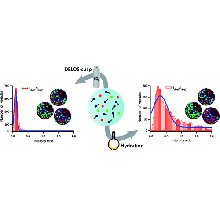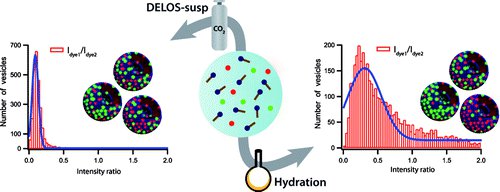Influence of the Preparation Route on the Supramolecular Organization of Lipids in a Vesicular System

Elisa Elizondo, Jannik Larsen, Nikos S. Hatzakis, Ingrid Cabrera, Thomas Bjørnholm, Jaume Veciana, Dimitrios Stamou, and Nora Ventosa;
J. Am. Chem. Soc., 2012, 134 (4), pp 1918–1921
DOI: 10.1021/ja2086678

Elisa Elizondo, Jannik Larsen, Nikos S. Hatzakis, Ingrid Cabrera, Thomas Bjørnholm, Jaume Veciana, Dimitrios Stamou, and Nora Ventosa;
J. Am. Chem. Soc., 2012, 134 (4), pp 1918–1921
DOI: 10.1021/ja2086678
A confocal fluorescence microscopy-based assay was used for studying the influence of the preparation route on the supramolecular organization of lipids in a vesicular system. In this work, vesicles composed of cholesterol and CTAB (1/1 mol %) or cholesterol and DOPC (2/8 mol %) and incorporating two membrane dyes were prepared by either a compressed fluid (CF)-based method (DELOS-susp) or a conventional film hydration procedure. They were subsequently immobilized and imaged individually using a confocal fluorescence microscope. Two integrated fluorescence intensities, Idye1 and Idye2, were assigned to each tracked vesicle, and their ratio, Idye1/Idye2, was used for quantifying the degree of membrane inhomogeneity between individual vesicles within each sample. A distribution of Idye1/Idye2 values was obtained for all the studied vesicular systems, indicating intrasample heterogeneity. The degree of inhomogeneity (DI) was similar for Chol/DOPC vesicles prepared by both procedures. In contrast, DI was more than double for the hydration method compared to the CF-based method in the case of Chol/CTAB vesicles, which can suffer from lipid demixing during film formation. These findings reveal a more homogeneous vesicle formation path by CFs, which warranted good homogeneity of the vesicular system, independently of the lipid mixture used.






